I’m sure you can’t fail to have noticed that there’s an election, and all the campaigning that goes along with it, in America right now. One particularly elemet of Barack Obama’s campaign caught my eye:
Everything is Multiplayer Now

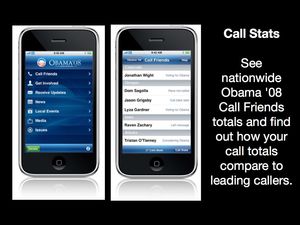
The iPhone application they built for volunteers. It makes it easy for volunteers to call people in their phone book and to see if they’re interested in voting Democrat. And there’s some nice functionality around that: marking down their response, listing who to call back. And then this feature caught my eye:
See nationwide Obama ’08 Call Friends totals and find out how your call totals compare to leading callers
You can compare your results to other people’s at any point. And I thought:

Oh snap, they just turned campaigning into an MMO.
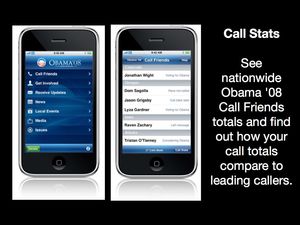
To begin with, the “game” is campaigning itself, if you like. But once you put that competitive element into it – in this case, a national high score table – it becomes something else.
Adding scores and competition to things is often described as if it’s some kind of “magic fun factor”. I’m not sure that’s enough: much as we like watching numbers go up, you need more than just a score to turn things into a game. But what’s important here is: they made campaigning, already a massive social activity, massively multiplayer.
What I’m going to talk about briefly today, is that Everything is Multiplayer Now.
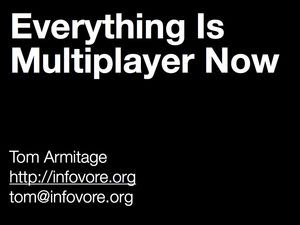
I work on the web, and I want to talk about some notions of “multiplayer” that apply to things that you don’t just play – things you use, and that you share. What games can learn from social software, and a few things that games are doing right and that other disciplines can learn from.
Social software is basically just software that’s about people. The web is exploiting new notions of multiplayer, of shared behaviour, that games are only beginning to tap into, and (indeed) vice versa. So I’m going to try to structure this a bit, but in 20 minutes, I think perhaps the best thing I can do is to string together some ideas that I think are interesting; what’s going to be important is what you make of this talk, not what I tell you.
And, as a little exercise, whenever I say “game”, see what happens if you replace that word with “app” or “software”, and vice versa. Some interesting things might happen.
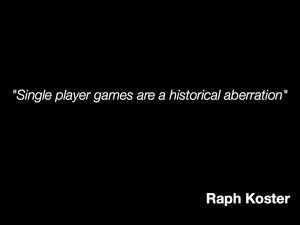
Raph Koster said that “single player games are a historical aberration” in his GDC talk of 2007.
and he explained it thus:
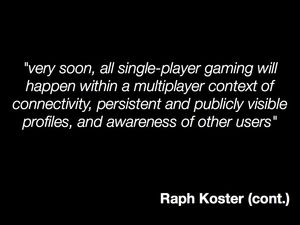
“very soon, all single-player gaming will happen within a multiplayer context of connectivity, persistent and publicly visible profiles, and awareness of other users”
I’d like to consider that most of our digital experiences on the web are no longer singleplayer, and what games can learn from that.
So first of all: who are the players on what, for sake of argument, I’ll call the modern web?

Consider this radial map of social relationships:
- me
- a partner (gaming, life, single friend)
- close friends / gaming crew
- less close friends / clan/guild
- “everyone you’ve ever known”
- strangers (“the rest of the world”)
These are present in life; they map onto the tools we use on the internet – from the direct messaging of email to the global reach of your average web page. And the social web actually makes most sense not at the genuinely massive scale – everyone I know – but at the middle levels.
Map these levels onto gaming:
- me
- player two, or the other person on the sofa
- your regular gaming crew
- your clan or guild
- everyone on your Live friendslist – all the people you’ve had One Good Game with
- total strangers
The really good stuff happens at the lower levels; some of the players you’ve had One Good Game with become closer friends.
Even a single player experience has a life outside itself, though.
Take a single player gaming experience. Even that has a social life outside of it:
- my friends who see me playing it
- everyone I tell about it the next day
- the replay I save and show to the world online
…and if you think of lone gaming experiences – playing multiplayer on your own – everyone else on other screens, watching it.

We take what *I* am doing and push it out into, to use a situationist term, the “spectacle“, if you like. Experience is commoditised: “Things that were once directly lived are now lived by proxy. Once an experience is taken out of the real world it becomes a commodity. As a commodity the spectacular is developed to the detriment of the real. It becomes a substitute for experience.“
The situationsists were very negative about the Spectacle; I don’t think we have to be so.
After all, we’re not sharing ourselves; we’re sharing an aspect of the game as an artefact. We have to move beyond people now, and consider what’s being played.
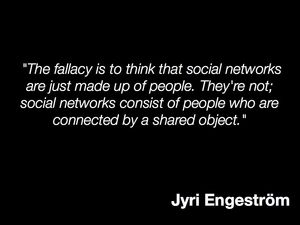
It’s important to consider that once separate from us, the artefacts we share have a life of their own; they become what Jyri Engeström calls social objects.
To quote Jyri, talking about social networks: “The fallacy is to think that social networks are just made up of people. They’re not; social networks consist of people who are connected by a shared object.“
His point is: successful social software pivots around objects. Hence things like Flickr’s focus on photographs, Youtube’s focus on video, Dopplr’s focus on trips, Upcoming’s focus on events. We take these objects – uploaded often as a singleplayer endeavour, if you like – and then we wrap people around them. “Multiplayer” implies that there is not just many players, but that something is being played.
So what are the social objects for games? What are the artefacts we can generate? How can games embrace a truly multiplayer world?
social objects: not games, but *playings* – our experiences therein. and they don’t have to just be playings. They could be:
- goals
- tricks
- runs
- great kills
- the fact that it’s a great shared memory that will make no sense to anyone else.
These are all in-game artefacts.
How are these shared? They might be shared in game. You see this in things like Halo’s replay-sharing facility, where I can send my friends movies over Xbox Live that they can interact with.
More interesting is sharing in-game experiences out-of-game. You can begin to see this in things like EA’s Skate and FIFA games, where it’s now possible to publish video on the web straight from game. See also Spore’s Youtube integration. Now you can share game experiences with people who haven’t necessarily got the game, or who might not be interested in it.
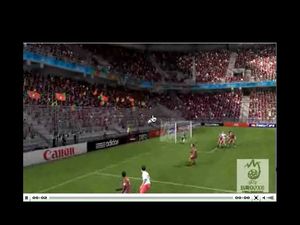
So here’s a great goal in the latest FIFA, spat out from the XBox and up to the web, to be viewed in Flash by your or me.
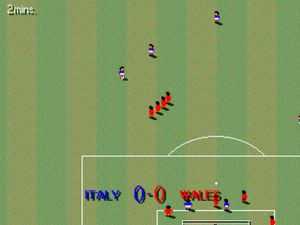
Compare that to Sensible Soccer. Here’s this pixelated, crude, pinbally football game, but it leads to the most epic tales of diving goals and injury-time saves. The shared artefacts Sensible Soccer tends to lead to are great tales, not grate videos.

We don’t just create the obvious artefacts of play, though; we create information around it – a layer of data and metadata. For instance: all the stats Bungie stores from your Halo games. These days, we’re all leaking data all over the shop; pushing out so much from our Oystercards, from our games, from our online presences, that we’re surrounding ourselves by a persistent layer of context. And when everybody’s doing this, we create a kind of

Supercontext (to borrow a term from Grant Morrison, and some thinking from Matt Jones): a vast overlay of shared data, where we can not only play with our own data, but with everybody else’s. Think about our dashboards on Flickr or Facebook, listing all our friends’ activity, merging all manner of flows of information, letting us pick and choose how we experience them. That’s a glimpse at the surface of the supercontext; what we can learn from it takes more time to discern.
You can make games out of data, too; after all, anything’s a game once you give it a score, right?

So take Nike+: it takes the solitary, worklike chore of running, and gives you a pretty graph. Not only that, it lets you share your graph with others – people you might know at work, but also strangers, in vast challenges. Sometimes, it’s fun to run with friends; sometimes, it’s fun to work as a team; and this makes the act of running alone more fun.
It’s time attack for your feet.
But it’s not just the score that makes it fun. You can’t just publish some inferred data and call that a game. It’s just a spreadsheet. Scores alone are not enough; a lot of the really good Web 2.0 properties all have gamelike properties to them – but that doesn’t necessarily make them games.
Let’s go back to Nike+ for a minute, though. What you see with Nike+ is metagames emerging, though. People start syncing late – filling up their run data and then only syncing at the last minute – to disguise how much they’re doing. They mess around!
The act gave us scores, and data, but it also gave us further scope for play.
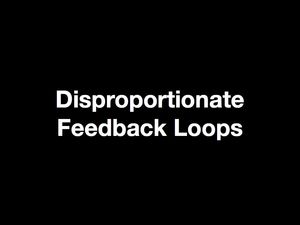
Nike+ gives us a kind of feedback loop – to help us improve our running. I’ve been describing games recently as “disproportionate feedback loops” – you do a thing, and something bigger happens, and this informs your next action, and so forth. Data is obvious a key constituent of this, and this kind of thing is clearly a neat thing, but as I said, scores alone aren’t enough to make a game. You know what else?
Games need to be magic. Interpret that how you will, but the best games are all, in their own way, magic.

There’s also a slight myth that multiplayer implies shared, synchronous, simultaneous activity.
That’s a good interpretation of it – it’s certainly the simplest – and perhaps reaches its zenith in
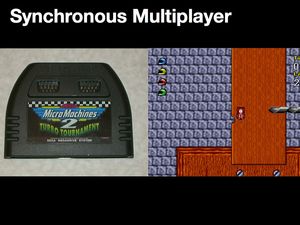
Micro Machines 2 on the Megadrive, a game that understood its strength as being one played in a single room with lots of mates, and it ran with that strength. First, it added two extra control ports (on the cartridge itself), meaning you could plug four joypads into your Megadrive. That’s a stroke of genius in itself, but that’s not all; the game actually supported up to eight players, by making you share pads – one player using three buttons for forward/left/right, the other using the d-pad. Eight players! What’s best about this is how it embraces the physicality of the situation: you have to get really close to your rivals, sitting right next to them, and one of the best tricks is a sneaky yank of the joypad or a jab in the ribs. It embraces the physcial context of multiplayer to actually change how you play.
But if you can’t get seven friends onto your sofa, there’s still some mileage in synchronous multiplayer online – the popularity of most online shooters and MMOs is testimony to that. Of course, synchronous multiplayer makes a lot of demands on people’s time.
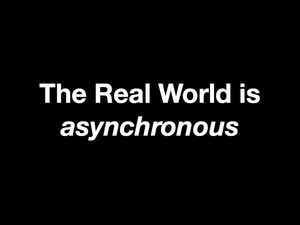
What we see in the social web, however, is asynchronous activity: users progressing at their own pace but still acting as part of the whole. Flickr is not a product I play with my friends; we use it seperately, but our actions are aggregated and contextualised via the dashboard. This is why Nike+ is so effective and compelling – it takes a disconnected event and connects it; it takes an asynchronous event (lots of people running at different times) and then pivots it into a new context (who is best over a distance). This is just as valid an approach to multiplayer as the synchronous approach. You see some games beginning to embrace this really well, thanks to good online integration; Geometry Wars 2 is one of my favourite examples.
Like any good arcade game, there’s a high-score in the top-right corner. What makes Geometry Wars 2 special is that it’s not just any high score; it’s the next highest score from your friends. When you beat it, it disappears – and the next highest score appears, and so-on. As I beat a friend’s score, I’d email him to let him know it had fallen – only for him to beat me back a few hours later. The presence of my friends is very obvious in the game, even though we all play it at different times.
Between these two aspects of multiplayer games we have something I’ve only just begun thinking about :
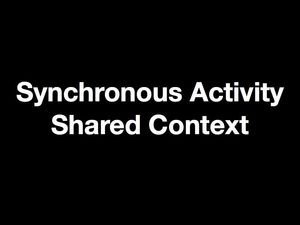
Synchronous activity in shared context. What do I mean by that?
Playing at the same time, but not necessarily in the same space. My favourite example of this right now is
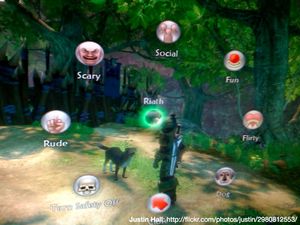
Fable 2. Whilst the actual co-op in Fable 2 is a little strange, the contextual information in it is delightful. As I play, I sometimes see orbs floating around, with icons in. These orbs are my friends, playing the game at the same time as me. It’s a real kick to know that your friends are seeing what you’re seeing, or in the same area. I can chat to them and give them stuff without necessarily having to play along with them. It’s a nice, social touch – a little glow that I’m part of something bigger, without requiring me to commit to simultaenous play (it is, however, a bit depressing when you see everybody doing the same chores-task).
You see this kind of thing in MMOs, too, with world events. The world events in WoW at the moment are a classic example: lots of stuff going on for Halloween, and whilst I’ve experienced some of this with friends, not everyone will see them at the same time. The events make a mark on our individual experiences, and become something we can talk about, without necessarily being like an instance that we all have to perform together.
And, of course, you see this in XBox Live itself: one of the things I love most is not playing with others, but knowning that others are playing; it’s like being in a little gang, I guess. I miss it a lot when I play games on the PS2, which is an offline console for me: no little boxes popping up, telling me that my friends are about.

There’s a lot of pressure from games on having fun together.
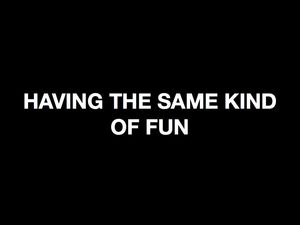
But I think that having the same kind of fun is just as valid an aspiration, and that’s not dependent on being about together. Having similar fun means you can talk about it later. The fun in Far Cry 2 is sharing stories about single-player mode, telling tall tales about our adventures in Africa; the combative multiplayer can’t compare to the virtual campfire tales on forums.
This seems so obvious on the web, or anything that isn’t a game, but it still seems rare in games at the moment.

I started out by saying that Everything Is Multiplayer Now. It’s a snappy title for sure, but I’m not sure it’s true, mainly because
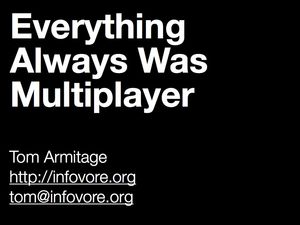
Everything Always Was Multiplayer. “No man is an island”; we exist as nodes in a great many networks, scattered through those concentric rings we saw at the beginnings; we’re partners, we’re friends, we’re buddies, we’re acquaintances. So much already is a shared endeavour, and that includes the social web, and that also includes games.
What’s changing is what notions of “multiplayer” might mean for software and for games. We now have the technology to extend the geographic reach of those networks further than ever before; we can’t recreate the experience of sharing a sofa with eight friends and four joypads, but we can perhaps recreate the experiences of happenstance, of competition-at-a-distance, sharing context if not spatial location.
“Multiplayer” is, in many ways, a broken term. It doesn’t just refer to a competitive deathmatch mode rushed out at the last minute, or an aggregation of all your friends data; it refers to every shared or social interaction that people have with a product. Multiplayer is, really, a sliding scale. It’s interesting to watch web products that understand this sliding scale of sociability; it’s exciting to watch games start to experiment with the nature of shared, social play. Now all we’ve got to do as designers, as developers, as producers, is to keep going, and to aim for the stars. And maybe we really can make the Spectacle of gaming Spectacular.